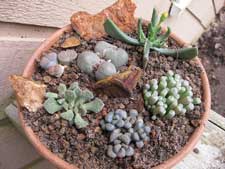Resource Library
Plant of the Week: Ice Plants
The University of Arkansas System Division of Agriculture does not promote, support or recommend plants featured in "Plant of the Week." Please consult your local Extension office for plants suitable for your region.
Plant of the Week
Ice Plants
Latin: Aizoaceae

Who's your daddy? In small town America, this is a common question as people formulate opinions based on what they already know about an individual's family. In the natural world, questions of kinship are equally important as scientists sort and classify organisms into meaningful groups.
In the past decade a quiet revolution has taken place amongst biologists as they try to overturn the long established Linnaean system of classification and replace it with a new scheme based on ancient relationships.
The accompanying photo is of a dish garden planting of six members of the ice plant family, the Aizoaceae. These six plants are all native to the deserts of South Africa and share common features such as their succulent leaves, a grayish green leaf coloration, opposite leaf arrangement, a small herbaceous stature, a unique means of photosynthesis known as CAM metabolism, and, were they all in flower, remarkably similar flowers. All of these plants are xerophytes, plants adapted to live in a desert environment.
Despite these similarities, botanists using the Linnaean system of classification decided they were sufficiently different for each to warrant its own distinct Latin name. In fact they were so distinct each of the six represents a distinct genus in the Linnaean system of classification. The ice plant family is a big family of plants with more than 1,800 distinct species, 96 percent of which are native to the southern half of the African continent.
In the early 1980s DNA technology became available and offered scientists another tool to use in an attempt to understand relationships in the natural world. Eventually a system emerged whereby three genetic markers were assayed in the cells of a wide array of organisms. From this information they began constructing a family tree, starting with the trunk.
Taxonomists using the Linnaean system of classification built family trees too, but they started with the leaves and built backwards to the branches, limbs and trunk. Those using the APC system, or Angiosperm Phylogeny Group, see themselves as big-picture biologists not concerned with individual species. In fact their system stops at the family level, preferring to work in clades - groups of genetically related species. This new system adds time - the millions of years of geological time - to the system of plant classification and allows scientists to project backwards toward ancient forms that must have once existed but are now extinct.
The APC system does show some interesting relationships amongst my dish garden planting of ice plants and the world as it existed a couple hundred million years ago. Both the APC system and the older Linnaean system classify the ice plant family into a larger grouping, the carnation order (the Caryophyllales). This grouping places it alongside the cactus family that occurs only in the New World. Cactus and ice plant share similarities in flower form, flower pigmentation, CAM photosynthesis, their adaptation to dry, desert habitats and an ancient DNA genetic kinship.
When the supercontinent split, these distantly related plants used different evolutionary approaches to survive a desert environment. Cactus evolved by shedding their leaves and concentrating on their trunks for photosynthesis while ice plants minimized their trunks and developed specialized leaves.
Though the six succulents in the planter are botanically distinct, their care is essentially identical. These xeric ice plants require good drainage, bright sun and protection from freezing. I plant them in a mixture of half coarse sand and half potting soil and then water about once a week during the summer. If drainage is good it is difficult to overwater the plants during the summer, but still it is advisable to keep them on the dry side. In the winter they go to a cold greenhouse where the temperatures are kept above 40 degrees. During winter months they are watered only once every four to six weeks, depending on how cloudy it has been.
By: Gerald Klingaman, retired
Extension Horticulturist - Ornamentals
Extension News - July 17, 2009
The University of Arkansas System Division of Agriculture does not maintain lists of retail outlets where these plants can be purchased. Please check your local nursery or other retail outlets to ask about the availability of these plants for your growing area.